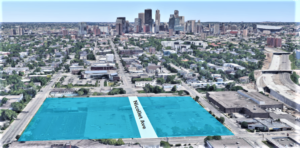BY ED FELIEN
In one of its last acts of 2021, the City Council approved a framework for beginning public discussions about what kind of development should happen when they re-construct Nicollet Avenue between 29th Street and Lake Street.
The press release announcing the plan said:
“The broad project goals include:
• Reconnecting people and places.
• Building safe, equitable and sustainable transportation networks.
• Building for who is there.
• Designing space to live, work, shop and play here.
• Designing safe and healthy communities.
“The public engagement framework includes three phases. The first phase will start in early 2022 and focus on creating open dialogues with community members who live, work, shop and visit the area. The second phase will focus on a public space plan and Nicollet Avenue layout plan, which will require City Council approval. The third phase of engagement will discuss the future development of buildings.”
From the City’s planning document, “Former Kmart & New Nicollet Project – Project Expectations,” published by the Business, Inspections, Housing, and Zoning Committee on Nov. 30, 2021:
“The City will conduct multiple phases of public engagement for the former Kmart & New Nicollet project. Engagement with diverse stakeholders, specifically those who live and work in the area, will help City leadership and staff understand how community needs and solutions can be incorporated into the project. Engagement will seek input on many topics, including the following examples:
• Benefits and challenges of owning a business in the area
• Benefits and challenges of living in the area
“Retail – What we know:
1. Commercial uses (stores, restaurants, etc.) will be required on the first floors of new development facing Nicollet Ave. and Lake St. Entrances must be directly from sidewalks.
2. Development will prioritize attracting culturally diverse businesses that create positive community impacts and reconnect Eat Street with Nicollet Ave. south of 29th St.
3. Development teams will prioritize including strategic partners who are experienced in recruiting and supporting local businesses that reflect the surrounding area.
4. Development will prioritize serving the needs of residents by increasing the diversity of available goods and services, while protecting the cultural assets already in the area.
“What wealth-building strategies for low-wealth communities are best suited for and able to be implemented in the project?”
This is a dare-to-dream fantasy projection come true – a great opportunity for the people in South Minneapolis who believe in cooperatives to build a valuable resource.
Why can’t the visionaries and architects who built the Seward Co-op Friendship Store at 38th and Clinton build a 14-story building with a food co-op store on the first floor, offices for local businesses on the next five floors, and studios for artists on the next eight floors? People living in the Whittier, Lyndale, Phillips and Powderhorn communities should be eligible to buy space at 50% of the market value of the unit and become members of the governing board running the co-op building.
That would be the best way to build community wealth – by investing in the people who actually live in the community.
Why can’t businesses get started? Why can’t musicians practice? Why can’t artists paint or writers write or sculptors sculpt?
Because, as Jimmy McMillan, candidate for governor of New York 20 years ago, said, “The rent is too damn high!”
Let’s do something about it.
Let’s build space for next year’s dreams.






















